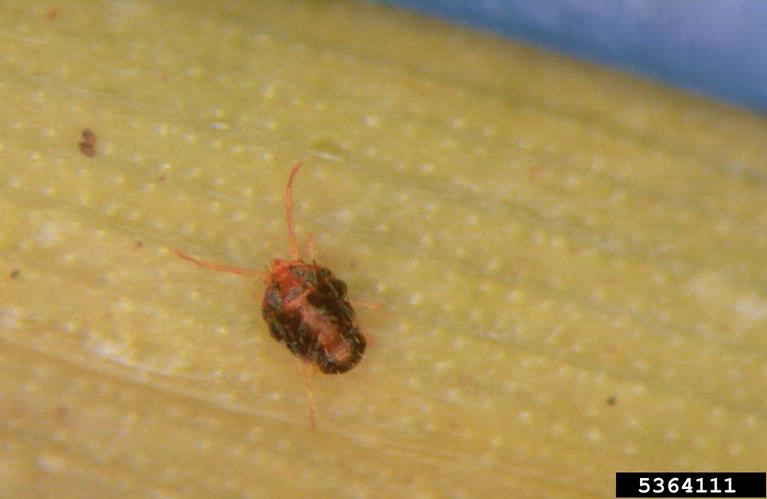Mites (Acariformes)
Biology and life history: Mites are very small (0.02 inches or smaller) and sometimes hard to see with the naked eye. They have stylet-like mouthparts that feed on plant epidermal cells. Several species of mites are known to damage agronomic and horticultural crops, and wild grasses. Winter grain mite (Penthaleus major), brown wheat mite (Petrobia lateens), Banks grass mite (Oligonychus pratensis), and wheat curl mite (Aceria tosichella) are some of the most common mites known to damage cereal crops and grasses in the Pacific Northwest. Adult winter grain mite is blue with reddish-orange legs, while brown wheat mite is red-orange to dark brown. Banks grass mite is green to yellow and wheat curl mite is white. Eggs are small white with round to oval. Winter grain mite and brown wheat mites are cool-season mites. Their over-summering eggs hatch in late summer/early fall and their young and adult feed on grasses and cereals from fall to spring. However, Banks grass mite is a hot weather mite that builds populations through the summer. Wheat curl mite overwinters as eggs, nymphs, or adults.
Host plants and crop damage: Heavy mite damage to plant leaves can be visible due to yellow, brown, white, or silver discoloration. Populations of winter grain mite reach their highest densities in fall through spring, damaging any grasses or crops available during this time. Winter grain mite and brown wheat mite feeding stunt plant growth or damage leaves. Banks grass mites are dormant in winter, overwintering in soil as fertilized adult females. Plant damaged by Banks grass mites look white flecking changing to yellowish, silver and bronze. Due to its silk webbing on leaves, damage of Banks grass mite resembles to that of the spider mites. Banks grass mite hides feeding at the base of the grass plant. In addition to its direct damage, wheat curl mite is known to vector Wheat streak mosaic virus, which is a serious virus in wheat.
Management: Integrated pest management tools are not well developed to manage these mites. Burning of infested crops or pastures are in practice, but they are not always effective. Some predatory mites and other natural enemies may control mite populations, but the effects are poorly understood. Hot temperatures and dry, dusty conditions exacerbate problems from these mites. If cases are severe, pesticides are used to manage winter grain mite and brown wheat mite, but the chemicals are less effective controlling Banks grass mite and wheat curl mite. Wheat curl mite can be effectively managed if volunteer wheat or other grasses are controlled as these plants can act as “green bridge” until the new wheat crop emerges. Rotating cereal crops with broad leaf crops such as sunflower, peas, canola, and lentils help reducing the infestation of these mites on cereal crops.

